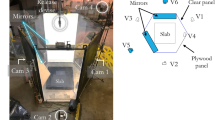Abstract
A discrete element code with impact model has been developed and calibrated to simulate the dynamic behavior of rock materials, with special regard to rock fragmentation upon impact during rock-fall analysis. The paper summarizes the discrete element code, the calibration algorithms developed to identify the model microparameters, and the impact model. Experimental work on drop tests is then used to validate the code on modeling impact fragmentation. It has been found that the developed discrete element code and impact model can reasonably simulate rock fragmentation in drop tests. The use of the discrete element code and impact model can provide good reference results in evaluating impact fragmentation in rock-fall analysis.









Similar content being viewed by others
References
Cundall PA, Hart R (1992) Numerical modeling of discontinua. J Eng Comp 9:101–113
Hentz S, Daudeville L, Donze F (2004) Identification and validation of a discrete element model for concrete. J Eng Mech 130(6):709–719
Hoek E, Diederichs MS (2006) Empirical estimation of rock mass modulus. Int J Rock Mech Min Sci 43(2):203–215
Lequang A, Junichi K (2003) Deformation characteristics of geomaterials. Lyon, France
Lin C, Amadei B, Jung J, Dwyer J (1996) Extensions of discontinuous deformation analysis for jointed rock masses. Int J Rock Mech Min Sci Geomech Abstr 33(7):671–694
Potyondy DO, Cundall PA (2004) A bonded-particle model for rock. Int J Rock Mech Min Sci 41(8):1329–1364
Richart FE, Hall JR, Woods RD (1970) Vibrations of soils and foundations. Prentice-Hall, Englewood Cliffs
Wang Y (2009) Three-dimensional rock-fall analysis with impact fragmentation and fly-rock modeling. University of Texas at Austin, Austin
Wang Y, Tonon F (2009) Modeling Lac du Bonnet granite using a discrete element model. Int J Rock Mech Min Sci 46(7):1124–1135
Wang Y, Tonon F (2010) Calibration of a Discrete Element Model for Intact Rock up to its Peak Strength. Int J Numer Anal Methods Geomech 34(5):447–469
Acknowledgments
This research was carried out when the first author was a doctoral student at the University of Texas at Austin. The authors are grateful to Rio Tinto for sponsoring this research work under the project “Three-dimensional rock-fall analysis with impact fragmentation and fly-rock modeling”.
Author information
Authors and Affiliations
Corresponding author
Appendix
Appendix
See Table 1
Rights and permissions
About this article
Cite this article
Wang, Y., Tonon, F. Discrete Element Modeling of Drop Tests. Rock Mech Rock Eng 45, 863–869 (2012). https://doi.org/10.1007/s00603-012-0272-8
Received:
Accepted:
Published:
Issue Date:
DOI: https://doi.org/10.1007/s00603-012-0272-8




